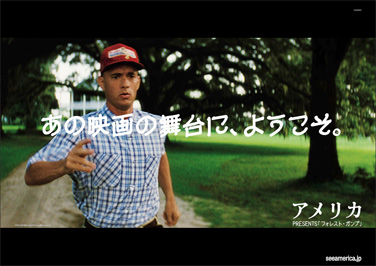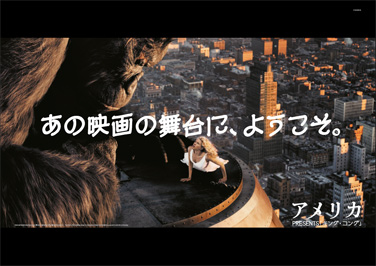|
|
|
|||||||||
|
Tourism Marketing Campaign Promotes U.S. Destinations to Japanese Travelers
In support of the $100 billion international travel and tourism industry, the U.S. Department of Commerce, in concert with many private-sector partners, has just launched a campaign in Japan to promote the United States as a tourist destination. This past June, the U.S Department of Commerce launched a new international tourism promotion campaign in Japan, using the theme “You’ve Seen the Films, Now Visit the Set.”™ The campaign uses clips and stills from American films featuring U.S. destinations to showcase the United States as an exciting place to visit. The fully integrated market campaign was developed and implemented by the U.S. Department of Commerce’s Office of Travel and Tourism Industries (OTTI) and the Visit America Alliance, which includes Edelman, a public relations firm; M&C Saatchi, an advertising agency; and their subcontractors. The campaign was based on detailed consumer research. Its advertising components included 30-second commercials for television and cinema, billboard posters in Tokyo subway and train stations, and special promotions in stores and online.
(Story continues below.)
The objectives of the campaign are to increase awareness of and interest in the United States as a travel destination, to encourage future interest in visiting the United States, and to b ring economic benefits from visits to U.S. destinations. Japan ranks first in producing tourism receipts, generating $16.5 billion in 2005, an increase of 26 percent over 2004. It is the fourth-largest arrivals market in terms of number of visitors. In 2005, 3.9 million Japanese visited the United States, a 4 percent increase over 2004. Ana Guevara, the deputy assistant secretary of commerce for services, kicked off the campaign on June 19, 2006, in Tokyo. J. Thomas Schieffer, U.S. ambassador to Japan, joined Guevara in announcing the campaign at various events during the week. Partnerships Enhance Campaign The Commerce Department’s tourism office worked closely with the U.S. and Foreign Commercial Service’s office at the U.S. embassy in Tokyo, as well as with advertising and public relations contractors, to create the campaign. The Commerce Department also developed several key partnerships that will support the success of the campaign. One of those partners, the Travel Industry Association of America (TIAA), donated the use of its Web site for the campaign. The TIAA site now has new content that has been translated into Japanese, which makes the site fully functional as a marketing tool to the Japanese public. Other partners in the campaign include two Japanese retails chains, Tsutaya and Mitsukoshi. Tsutaya is Japan’s largest record, book, and DVD retail outlet, and Mitsukoshi is Japan’s oldest and most prestigious department store. Both retailers are promoting the campaign through sweepstakes and promotional prize giveaways. Prizes include airline tickets, deluxe hotel stays, travel merchandise, and generous grand prize packages. Nearly 50 travel and tourism industry partners from both countries are supporting the campaign. Following in the Steps of Successful U.K. Campaign This current campaign is a follow-up to a similar 2004 campaign in the United Kingdom. Advertising in that campaign increased consumer awareness in the United Kingdom by reaching approximately 12.8 million people. According to a postcampaign survey, people who had seen the promotion were 10 percent more likely to mention the United States as a “dream destination.” The campaign increased the number of people who said they intend to travel to the United States by approximately 2 million. A high percentage of those intended travelers actually converted into sales, with 362,000 visitors who saw the campaign reporting that they had booked a trip to the United States. First-year results of the U.K. campaign, as reported by Longwoods International, an independent research firm, indicated that the return on investment for the campaign was $117 per $1 invested in advertising. Julie Heizer, an international trade specialist in the International Trade Administration, contributed to this report. |
|

